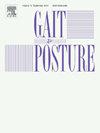股骨骺滑脱患儿原位固定或改良邓恩手术后两年的 3D 步态结果
IF 2.2
3区 医学
Q3 NEUROSCIENCES
引用次数: 0
摘要
背景股骨头骨骺滑脱(SCFE)是指股骨头从股骨颈穿过骨骺滑脱,好发于8-16岁的儿童。研究问题与正常参考值相比,接受原位固定术(PIN)或改良邓恩术(MDP)的 SCFE 儿童两年后的 3D 步态结果如何?方法17名接受过PIN(7人,滑脱严重程度为轻度至中度)或MDP(10人,滑脱严重程度为中度至重度)手术治疗的SCFE患儿在术后(2∙0 ± 0∙5 年)接受了三维步态分析。同时还招募了 10 名年龄匹配的儿童,以提供常模参考值。对传统步态模型进行了修改,加入了 Hara 髋关节方程和 Lerner 骨盆跟踪方法。结果通过步态轮廓评分确定的总体步态模式表明,SCFE 两组均与常模参照组存在差异(PIN 6∙6 ± 2∙5⁰, MDP 6∙2 ± 2∙0⁰ vs. 常模 4∙0 ± 1∙3⁰, p<0∙05)。与常模参照组(0∙46 ± 0∙06;p=0∙032)相比,MDP组的正常化步行速度降低了(0∙40 ± 0∙04)。在 PIN 组中观察到的髋关节外旋增加可能是成年后骨关节炎的前兆。因此,使用可使髋关节旋转恢复正常的矫正性 MDP 可能有利于减少功能障碍。本文章由计算机程序翻译,如有差异,请以英文原文为准。
Two-year 3D gait outcomes following in-situ pinning or modified Dunn procedure in children with slipped capital femoral epiphysis
Background
Slipped Capital Femoral Epiphysis (SCFE) is femoral head slippage off the femoral neck through the physis occurring in children aged 8–16 years. Surgical intervention is required in all paediatric cases and there is no universal agreement on choice of surgical procedure.
Research question
What are the two-year 3D gait outcomes in children with SCFE who have undergone in-situ pinning (PIN) or modified Dunn procedure (MDP) compared with normative reference values?
Methods
17 children with SCFE who had undergone PIN (n=7, slip severity mild to moderate) or MDP (n=10, slip severity moderate to severe) surgical procedures prospectively underwent a 3D gait analysis post-surgery (2∙0 ± 0∙5 years). Ten age-matched children were also recruited to provide normative reference values. The conventional gait model was modified to incorporate Hara hip equations and Lerner pelvic tracking methods. Gait Profile Scores, Gait Variable Scores, kinematics, kinetics and spatiotemporal data were calculated for each group.
Results
Overall gait pattern, determined by the Gait Profile Score, indicated that both SCFE groups differed from the normative reference group (PIN 6∙6 ± 2∙5⁰, MDP 6∙2 ± 2∙0⁰ vs. 4∙0 ± 1∙3⁰ norm, p<0∙05). Normalised walking speed was reduced in the MDP group (0∙40 ± 0∙04) compared to the normative reference group (0∙46 ± 0∙06; p=0∙032).
Significance
Gait patterns of children with SCFE treated with PIN was more markedly altered than that of children with SCFE treated with MDP, despite having lower SCFE severity. Increased external hip rotation observed in the PIN group may be a pre-cursor for osteoarthritis in adulthood. Therefore the use of the corrective MDP which normalises hip rotation may be beneficial for reducing functional impairments.
求助全文
通过发布文献求助,成功后即可免费获取论文全文。
去求助
来源期刊

Gait & posture
医学-神经科学
CiteScore
4.70
自引率
12.50%
发文量
616
审稿时长
6 months
期刊介绍:
Gait & Posture is a vehicle for the publication of up-to-date basic and clinical research on all aspects of locomotion and balance.
The topics covered include: Techniques for the measurement of gait and posture, and the standardization of results presentation; Studies of normal and pathological gait; Treatment of gait and postural abnormalities; Biomechanical and theoretical approaches to gait and posture; Mathematical models of joint and muscle mechanics; Neurological and musculoskeletal function in gait and posture; The evolution of upright posture and bipedal locomotion; Adaptations of carrying loads, walking on uneven surfaces, climbing stairs etc; spinal biomechanics only if they are directly related to gait and/or posture and are of general interest to our readers; The effect of aging and development on gait and posture; Psychological and cultural aspects of gait; Patient education.
 求助内容:
求助内容: 应助结果提醒方式:
应助结果提醒方式:


